
Tudhoe & Spennymoor Local History Society
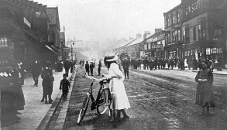


Prior to 1840, Spennymoor did not exist as a town. However, Spenny Moor as a place did; located on the plateau south of the River Wear between the Bishop of Durham’s palace at Auckland Park and the Great North Road at Sunderland Bridge, it was described by Robert Surtees, County Durham’s great nineteenth century historian, as an ancient waste or common. In medieval times, the surrounding villages of Whitworth, Tudhoe, Kirk Merrington, Westerton, Middlestone, Ferryhill, Hett, and Tursdale, all had rights of common on Spenny Moor. The area was also a strategic location where armies were mustered; notably, in October 1536, when 10,000 rebels taking part in the Pilgrimage of Grace assembled there before marching under St. Cuthbert’s Banner to vainly challenge Henry VIII’s reformation of the church and ensure that :
the supremacy of the Church ... be reserved to the See of Rome as before…
Of the five old settlements that make up the modern Spennymoor Town Council area, Tudhoe, Whitworth, Old Park, Byers Green and Kirk Merrington, the last named has the earliest recorded event. In 1143, during a conflict over the succession to the Bishopric of Durham, Merrington Church, which is Saxon in its origins, was seized and fortified by the supporters of William Cumin because of its strategic location on the escarpment above the River Wear. This strategic location was emphasised in 1346 when the English and Scots skirmished at Butcher Race east of Merrington prior to the Battle of Neville’s Cross.
In the later middle ages the Claxtons of Whitworth, supporters of the powerful Nevilles of Brancepeth and Raby, were the important landowners in the area. The Priory of Durham owned lands round Merrington and these passed to the Dean and Chapter of Durham Cathedral when Henry VIII suppressed the monasteries. In 1569, the Claxtons and Nevilles had their estates confiscated by the crown for their role in the pro Catholic Rising of the Northern Earls. Records show that 25 men from Tudhoe, Whitworth, Merrington and Byers Green joined the rebellion and that seven of them were executed.
After 1600, some of the Claxton lands round Tudhoe were acquired by the Salvins, long established at Croxdale Hall and also a Catholic family. As a result the village adhered to the old religion during the seventeenth and eighteenth centuries when recusants were fined and barred from office holding. In the mid seventeenth century, at a time when field enclosures were changing the character of Spenn Moor’s ancient waste, Whitworth was acquired by Mark Shafto, a Newcastle lawyer and the ancestor of Bonnie Bobby Shafto. The smaller estate of Old Park had earlier been bought by the Wharton family, which included a line of important London physicians. The last of these, Thomas Wharton was a close friend of the poet Thomas Gray. When Gray visited Old Park in the 1760s, Wharton’s directions for the journey from Darlington were :
it is about 16 miles, and runs by Kirk Merrington, and Spenny-moor House; a little rough, but not bad or dangerous in any part.
It was to Byers Green, close to Old Park, where, in 1762, Thomas Wright, known as the Wizard of Durham, retired from this peripatetic life as a mathematician, astronomer and landscape designer.
Here … you will find my … villulet, for I cannot well call it a villa from its miniature, situated as in a vast amphitheatre, bounded by high hills on every side, through which a beautiful river winds ….
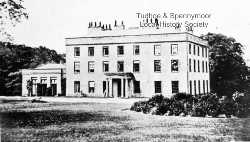
Wright had been born in Byers Green in 1711 and had been educated in King James I Grammar School in Bishop Auckland before being apprenticed to a clockmaker in the town. By 1734, after various adventures, Wright had progressed to making a huge working model of the universe (an orrery) for an aristocratic London patron. This set him on his remarkable career that included the first accurate description of the Milky Way.
Robert Shafto of Whitworth was MP for County Durham when Wright returned to Byers Green and one interpretation of the famous rhyme Bonnie Bobby Shafto is that it was an old song modified to drum up support in the election of 1761. The following extract from verse five is indicative of the bribery then involved in elections :
Bobbie Shafto throws his gold, Right and left like Knights of old.
Others suggest that the last verse (Bobbie Shafto’s gone to sea) alludes to Shafto jilting the heiress, Miss Bellasyse, of Brancepeth Castle. In 1774, Robert Shafto did marry an heiress, Anne Duncombe, of Duncombe Park near Helmsley. He then became MP for Wiltshire, where his wife had estates, and died at Whitworth in August 1797.
At the turn of the eighteenth century, when Shafto died, Whitworth, Tudhoe, Byers Green, Old Park and Merrington were still agricultural settlements, with industry limited to a few small coal pits and a paper mill established at Tudhoe in the 1790s. Charles Waterton, who was boarding at Tudhoe Academy, described how the rural environment of those years nurtured the naturalist he became and :
…afforded an ample supply of woods and hedgerow trees to ensure a sufficient supply of carrion-crows, jackdaws, jays, magpies, brown owls, kestrels, merlins and sparrow-hawks, for the benefit of natural history and my own instruction and amusement … .
Tudhoe Academy was a boarding school for “the sons of Catholic gentlemen or very reputable merchants”, probably set up with the support of the Salvin family. It closed in 1808 when the seminary at Ushaw College was built, but later in the century the site was used for St. Charles’ Church and St. Mary’s Convent Homes.
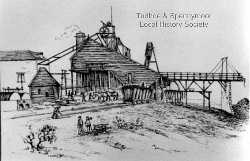
The change from the agricultural economy to an industrial one was promoted by the Shaftos and Salvins. Bobbie Shafto’s son, Robert Eden Duncombe Shafto, supported the Clarence Railway Act in 1828 and the sinking of Whitworth Park Colliery in 1839. Both enterprises were operating by 1841 and the Census of that year showed New Spennymoor as a distinct place, with a population of about 150 including sinkers, excavators and pitmen. However, even with good railway links provided, Whitworth Colliery was not profitable and it was on Salvin land that the most significant industrial expansion took place.
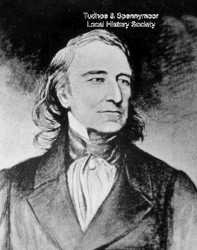
Tudhoe Ironworks was built in 1853 by the Weardale Iron Company, headed by Charles Attwood, son of a Midlands ironmaster who had previously run the Tyne Glassworks in Gateshead. Attwood, with the support of Barings Bank, first invested in ironworks at Stanhope and Tow Law and, then, when Tudhoe Ironworks was established brought in Bessemer Converters to make steel. The success of iron and steel making led to investment in Tudhoe Colliery in 1864 in order to supply coking coal for the furnaces.
In 1864 Spennymoor officially came into existence, being governed by a Local Board of Health of nine members. The expansion of the town had been rapid; not long before Whelan’s Directory of 1856 had noted
Twenty years ago, the name was confined to a single farm held in the Whitworth estate; but now Spenny Moor is a considerable village … and, from the rapidity with which buildings are being erected, will shortly assume the appearance of a considerable town.
The town’s creation was much influenced by George Stratton, the Scottish land agent working for the Shafto estate. Stratton lived in Spennymoor House and then, as the town expanded, Clyde House. The original Spennymoor boundary stopped at the Valley Burn which was the limit of the Shafto estate, with the Salvin estate being on the other side of the burn, known colloquially as the Jordan. William Fleming, the Salvin agent, was also a Scot and came to Tudhoe in 1844, living first at Academy Farm and then at Tudhoe Villas (the now sadly ruined Woodlands). Fleming, working for Marmaduke Salvin, was responsible for the development of Tudhoe Grange, which, as well as the Ironworks and Colliery, included workers’ housing of semi-detached cottages on quarter acre plots built between 1865 and 1870. Pevsner described this development as “a remarkably far-seeing contribution to the problem of working class housing”. However, conditions in much of the housing in Spennymoor were poor and, in 1884, over 80 homes were condemned in a medical officer’s report as unfit for human habitation. This led to disease and high infant mortality, a problem that persisted, since in 1903 an even more critical report was made.
The solicitor, James J Dodd, who was Spennymoor’s first historian, wrote that the good times began to go back in 1873 and that the tide of misfortunes was crowned by the explosion at Tudhoe Colliery on 18th April 1882 in which 37 men and boys died. Dodd wrote his History in 1897, three years after Whitworth, Old Park and Tudhoe were united as the Urban District of Spennymoor. The Weardale Iron & Coal Company operations were at the heart of the new district and in 1894 were described as having :
assumed almost the character of a well organised, self contained little state … possessing their own steel and iron works, foundries, forges, and engineering shops, collieries, brick works, limestone quarries, gas works, and rolling stock etc., all the departments being connected by an elaborate network of telephones and private wires.
However, by 1901, the Company had been taken over and Tudhoe Iron and Steel Works closed. The site continued coke making until the 1950s; but, apart from short period during the First World War, the blast furnaces were silent.
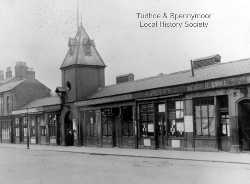
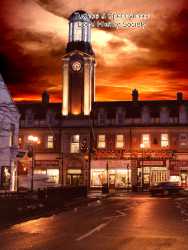
Spennymoor at the beginning of the twentieth century was a community of 18,000 people – not far short of today’s population. Many of today’s landmarks were there – Jubilee Park, laid out for Queen Victoria’s Golden Jubilee, St. Paul’s and St. Andrew’s churches consecrated in 1858 and 1884 respectively, Rosa Street School opened in 1870. Spennymoor Town Hall, which replaced original council offices built in High Street in 1870, opened in 1916. Its construction, which started in 1913, was delayed by the onset of the First World War. However, many landmarks of that period have gone – Holy Innocent’s Church, Spennymoor railway bridge and station and the Cambridge Theatre. Some have changed, for example Spennymoor United AFC formed in 1904, is now Spennymoor Town, the original name of the football team created in 1888 from the amalgamation of St. Paul’s and St. Andrew’s church teams.
The Great War, as it was known in its immediate aftermath, had as much impact in Spennymoor as it had in other communities throughout Britain. With men in the army and navy, women took up war work. It is not known how many Spennymoor men (and women) served in France, Belgium and other theatres of war (such as Italy and the Dardanelles). Recent research suggests that some 500 men from Spennymoor and District died in the War. Six died at the Dardanelles in one day in August 1915. The Urban District Council’s Book of Remembrance, produced in 1922, lists some 360 of the fallen and also lists survivors serving with distinction. These include Sister Kate Maxey who served in hospitals in France from October 1914 to March 1918, when she was severely wounded in a German bombing raid. She was awarded the Military Medal in 1918 and, in 1920, was one of the first recipients of the Florence Nightingale Medal.

A survivor also listed in the Book of Remembrance was Captain Thomas Welch M.C., Headmaster of the new Higher Elementary School opened in 1912. The school was renamed in 1922 in honour of Alderman G H Wraith, a mining engineer, director of the Weardale Iron & Coal Company and local politician. It later became Tudhoe Grange Comprehensive Lower School and was demolished in 2015. The Higher Elementary School opened too late for Harold Orton born in Byers Green in 1898. Orton, who as an academic at Oxford, Durham and Leeds Universities analysed how people in the area spoke, had to travel to King James I Grammar School in Bishop Auckland for his secondary education. He served in the Durham Light Infantry between 1917 and 1919, losing the use of an arm due to wounds. In 1930, Orton published The Phonology of a South Durham Dialect from which the following “touch-line conversation” is a translated (i.e. non-phonetic) extract :
Looks thou, see that? Did thou see what he did? Dirty foul, referee! Oh haraway, man, nothing of the sort. Why aye it was. He shoved his foot in from in ahint {behind} and chipped our Bill up. It was a mucky foul. Play the game, referee; thou wants to get thy eyes chalked man.
By 1930, after the difficulties of the 1920s in the aftermath of the Great War, Spennymoor was in the grip of the Great Depression. Chronic unemployment lasted throughout the thirties; in June 1936, the Spennymoor Employment Exchange area still had 27% of the insured population unemployed (2,826 people – at that time mainly men). Spennymoor Settlement, opened in 1931 with a grant from the Pilgrim Trust, aimed to support the unemployed by encouraging :
Tolerant neighbourliness and voluntary social service and {giving} its members opportunities for increasing their knowledge, widening their interests and cultivating their creative powers in a friendly atmosphere.
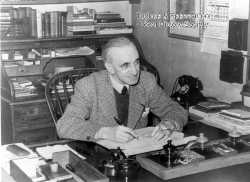
Run by the Warden, Bill Farrell, the Settlement was a great success, becoming known as the Pitman’s Academy. Unemployed men built the Everyman Theatre in 1939 and it is now the longest continuously serving Settlement building in the country. Notable among those coming to the Settlement in its early years was the artist, Norman Cornish (1919-2014), who joined the Sketching Club soon after starting work at the Dean and Chapter Colliery in December 1933. Cornish had passed his eleven-plus and attended the Alderman Wraith School but his family could not afford the costs of education after he was fourteen. In contrast, Percy Cradock, who was born in Byers Green in 1923 and who attended the Alderman Wraith School in the late 1930s, did stay on for his School Certificate. After war service in the RAF, he went to Cambridge University, was President of the Union there, joined the Foreign Office and ultimately became Margaret Thatcher’s advisor on foreign affairs.
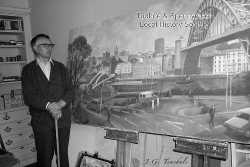
Despite the greater loss of life in the First World War, reflected in the War Memorials throughout the District, Spennymoor changed more as a result of the Second World War than the earlier conflict. The building of the huge Royal Ordnance Factory (ROF 21) on Merrington Lane brought new engineering industry to the town. Smart and Brown Engineering was established there in 1945, being taken over in 1951 by Thorn Industries. Spennymoor Settlement played an important part both during the war and after it, including playing host to the Old Vic company. In addition to Norman Cornish, Sid Chaplin, the novelist, and Tom McGuiness, another mining artist, trained there. As a result, Spennymoor has a rich cultural legacy from the twentieth century.
Although Tudhoe Colliery closed in 1936, Whitworth Park Colliery continued in production until 1974, by which time most of South West Durham’s collieries and railways had closed. However, with domestic appliance manufacturing well established at Thorns, the Government and local councils were able to attract other manufacturing industries to Spennymoor in the 1960s and 1970s including Black & Decker, Electrolux and Rothmans. At the same time the dereliction caused by coal and iron making was dealt with as part of a County-wide Reclamation Programme. This was implemented so efficiently that nothing now remains of the town’s railway, collieries and ironworks.
Local Government reorganisation in 1974 saw the establishment of Spennymoor Town Council and Sedgefield District (later Borough) Council, the former using the Town Hall offices built for the predecessor Spennymoor UDC and the latter taking over the redundant Green Lane offices of the National Coal Board. As a result Spennymoor’s leisure and community facilities have been significantly improved and the town now has a regional gymnastics centre and a successful boxing academy. The Borough Council was wound up in 2009, and the area is now part of the two tier local government system of Durham County Council and Spennymoor Town Council. The new councils face tremendous challenges following the closure of much of Spennymoor’s manufacturing industry during the last decade.
In recent years the Town Council, supported by the Area Action Partnership, has promoted the use of Spennymoor Town Hall as a focus for the culture and heritage of Spennymoor. The Town Hall now houses the Durham Mining Museum and the Bob Abley Art Gallery. In the latter, in addition to regularly changing exhibitions of newly created works by local artists, art created by members of the Settlement Sketching Club can be seen on permanent display. Happily, Spennymoor Settlement itself has been refurbished for the 21st century and still houses the Everyman Theatre and an Art Group.
John Banham 2015 Tudhoe & Spennymoor Local History Society.
See the Society’s photographic collection of Spennymoor’s 20th century heritage compiled by Tony Coia, George Teasdale, the late Brian Wilcockson, Mike Ord and Bob Abley.